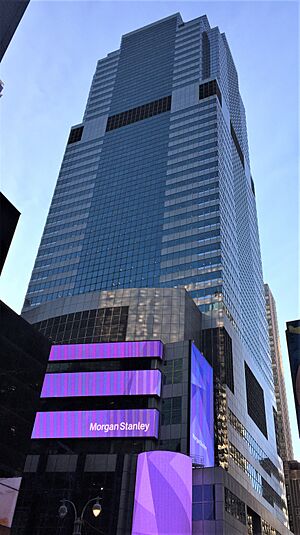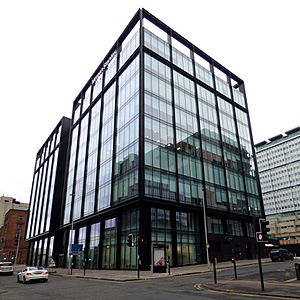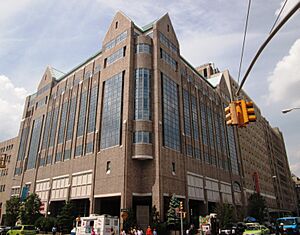Morgan Stanley facts for kids

Headquarters at 1585 Broadway
|
|
| Public | |
| Traded as | |
| Industry | Financial services |
| Founded | 1935 |
| Founders |
|
| Headquarters | Morgan Stanley Building New York City, New York, U.S. |
|
Area served
|
International service |
|
Key people
|
|
| Products |
|
| Revenue | |
|
Operating income
|
|
| AUM | |
| Total assets | |
| Total equity | |
| Owner | Mitsubishi UFJ Financial Group (23.3%) |
|
Number of employees
|
80,000 (2024) |
| Subsidiaries |
|
| Capital ratio | 15.2% (2023) |
Morgan Stanley is a big American company that helps people and businesses with their money. It's called an investment bank and financial services company. Its main office is in New York City.
Morgan Stanley has offices in 42 countries and employs over 80,000 people. Its clients include large companies, governments, and individuals. The company is known as one of the biggest in the United States by its total earnings.
The first Morgan Stanley company started on September 16, 1935. It was created by Henry Sturgis Morgan and Harold Stanley, who used to work for J.P. Morgan & Co.. They started a new company because a law called the Glass–Steagall Act made it necessary to separate different types of banking.
The Morgan Stanley you see today is the result of a merger in 1997. The original Morgan Stanley joined with another company called Dean Witter Discover & Co.. The new company later changed its name back to "Morgan Stanley" in 2001. Today, Morgan Stanley mainly focuses on helping large organizations, managing people's wealth, and handling investments.
Contents
How Morgan Stanley Started and Grew
The Early Years (1935–1997)
Morgan Stanley's story begins with J.P. Morgan & Co.. In 1933, the U.S. Congress passed a law that changed banking. This law meant that banks could no longer do both investment banking and regular commercial banking under one roof.
J.P. Morgan & Co. chose to focus on commercial banking. So, some of its employees, like Henry S. Morgan and Harold Stanley, left to start Morgan Stanley. The new company officially opened on September 16, 1935, in New York City.
One of their first big jobs was helping United States Steel Corporation raise money in 1938. They also helped with a major U.S. rail financing project in 1939. In 1941, the company changed its structure to do more work with buying and selling stocks and bonds.
From 1951 to 1961, Perry Hall led Morgan Stanley. During this time, the company helped the World Bank with its bonds. They also helped big companies like General Motors, IBM, and AT&T raise money.
In 1962, Morgan Stanley was one of the first companies to use computers for financial analysis. This was a new and important step in how financial companies worked. In 1967, they opened an office in Paris to expand into Europe. They also started working in real estate. In 1996, Morgan Stanley bought a company called Van Kampen American Capital.
After the Merger (1997–Present)
On February 5, 1997, Morgan Stanley merged with Dean Witter Discover & Co.. This new company was first called "Morgan Stanley Dean Witter Discover & Co." Later, in 2001, the name was shortened to just "Morgan Stanley."
Morgan Stanley had many offices in the World Trade Center buildings. Sadly, 13 employees were lost during the September 11 attacks in 2001. However, a security director named Rick Rescorla helped nearly 2,700 employees safely leave the buildings. After the attacks, the surviving employees moved to temporary offices. In 2005, Morgan Stanley moved many employees back to lower Manhattan.
In 2003, New York–Presbyterian Hospital named its children's hospital the Morgan Stanley Children's Hospital. This was to thank the company for its support and donations, which helped build the hospital. Morgan Stanley employees have been involved with the hospital for many years.
In 2007, Morgan Stanley separated from its Discover Card unit. Also, in 2007, they ended a partnership in India and set up their own company there.
During the 2008 financial crisis, many banks faced big challenges. Morgan Stanley also faced difficulties, but it made important changes to stay strong. On September 22, 2008, Morgan Stanley and Goldman Sachs decided to become traditional bank holding companies. This meant they would be regulated by the Federal Reserve, like other banks.
On September 29, 2008, MUFG Bank, a large Japanese bank, invested $9 billion in Morgan Stanley. This gave MUFG Bank a 21% ownership in the company. This investment helped Morgan Stanley during a difficult time.
In 2009, Morgan Stanley bought Smith Barney from Citigroup. This created Morgan Stanley Smith Barney, which became the largest wealth management business in the world. Wealth management means helping people manage their money and investments.
In November 2013, Morgan Stanley announced it would invest $1 billion to help improve affordable housing. This was part of a larger effort to support economic and social well-being.
In October 2020, Morgan Stanley bought E-Trade for $13 billion. E-Trade is a company that helps people trade stocks online. This was one of the biggest purchases by a U.S. bank since the 2008 financial crisis. In March 2021, Morgan Stanley also bought Eaton Vance. With these additions, Morgan Stanley now manages a huge amount of money for its clients.
In October 2024, Morgan Stanley made an agreement with a company called Climeworks. They agreed to buy 40,000 tonnes of carbon dioxide removal. This shows their commitment to helping the environment. In January 2025, Morgan Stanley decided to leave the Net-Zero Banking Alliance, but they still plan to help the world move towards net-zero carbon emissions.
How Morgan Stanley Works
The company has three main parts:
Institutional Securities Group

| Business unit | share |
|---|---|
| Wealth Management | 48.5% |
| Institutional Securities | 42.6% |
| Investment Management | 9.9% |
| Intersegment Eliminations | -1.0% |
This part of Morgan Stanley helps large organizations like companies and governments. They offer services like investment banking, which means helping companies raise money. They also give financial advice, for example, when companies want to merge with or buy other companies. This group also handles trading stocks and bonds.
Wealth Management
This group helps individuals manage their money and investments. They provide advice on financial planning and how to invest. Their clients are often people who have a lot of money.
In 2009, this group joined with Citi's Smith Barney to form Morgan Stanley Smith Barney. Morgan Stanley gradually bought more of this joint venture. By June 2013, Morgan Stanley owned all of Smith Barney.
In February 2019, Morgan Stanley bought Solium Capital, a company that manages employee stock plans. In October 2020, they completed the purchase of E-Trade, which expanded their services for individual investors.
Investment Management
This part of Morgan Stanley manages money for different types of clients. These clients include pension plans, companies, and non-profit organizations. They invest money in various ways, like stocks, bonds, and real estate.
In 2009, Morgan Stanley sold its Van Kampen brand but kept its own Morgan Stanley brand for asset management. In March 2018, they bought Mesa West, a company that focuses on real estate loans. In March 2021, they completed the purchase of Eaton Vance, which added even more ways for them to manage client money.
Who Owns Morgan Stanley?
Morgan Stanley is mostly owned by large investment groups. As of December 31, 2024, the biggest owners include:
- Mitsubishi UFJ Financial Group (23.38%)
- State Street Corporation (6.90%)
- The Vanguard Group (6.83%)
- BlackRock (5.90%)
- JP Morgan Chase (2.54%)
Awards and Recognitions
Morgan Stanley has received many awards for its work and as a workplace:
- In 2020, it was named IFR's Bank of the Year.
- In 2021, Euromoney named it the best investment bank in the world.
- Fast Company listed Morgan Stanley as one of the Best Workplaces for Innovators in 2020 and 2021.
- In 2007, Great Place to Work Institute Japan ranked Morgan Stanley as the second best company to work for in Japan.
- The Times listed Morgan Stanley among the top companies to work for in 2006.
- Working Mother magazine named Morgan Stanley one of the 100 Best Companies for Working Mothers in 2004.
Where are Morgan Stanley's Main Offices?
Morgan Stanley's world headquarters are in New York City. Its main office for Europe is in London. For Asia Pacific, it has headquarters in both Hong Kong and Tokyo. The Canada headquarters are in Toronto. In the Middle East, offices are in Abu Dhabi, Dubai, Riyadh, and Qatar.
Well-Known People Who Worked at Morgan Stanley
Many notable people have worked at Morgan Stanley before going on to other important roles. Some examples include:
- Dan Ammann, former President of General Motors.
- Erskine Bowles, who was Chief of Staff for President Clinton.
- Bob Diamond, former CEO of Barclays.
- Ruth Porat, who is the chief financial officer of Alphabet Inc. (Google's parent company).
- Vikram Pandit, former CEO of Citigroup.
See also
 In Spanish: Morgan Stanley para niños
In Spanish: Morgan Stanley para niños
- Dean Witter Reynolds
- Discover Card
- MSCI
- Van Kampen Funds
- Metalmark Capital, formerly Morgan Stanley Capital Partners
- Morgan Stanley Smith Barney, a joint venture with Citigroup


